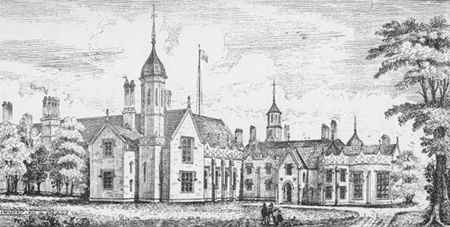|
|
|
| |
Belfast
Castle. |
|||
In 1573 the Earl of Essex visited the fortress, which the Irish had previously, on different occasions, frequently attempted to take by surprise; and in 1575 the Lord-Deputy Sydney encountered the Irish forces at the ford of Belfast. After the death of Elizabeth, the garrison, influenced by Hugh O'Nial, Earl of Tyrone, refused submission to the English crown; but, on the defeat of that powerful leader and his adherents, the English gained the ascendancy, and Sir Arthur Chichester, lord-deputy in the reign of James I., issued his summons requiring the supplies of horse and foot, according to the tenure by which the castle was held; and no one appearing in answer to this requisition, the castle and demesne became forfeited to the crown, and were given to Chichester in 1612. Arthur Chichester who implemented a scorched earth policy in north east Ulster, is credited with building but most likley he renovated the existing castle in 1611, subsequently he built a palatial residence in Carrickfergus, this house was named Joymount in honor of Lord Mountjoy, Chichester's Belfast Castle burnt down in 1704. Chichester from Raleigh, in Devon, England, shortly after his arrival in Ireland he is said to have been on the verge of bankruptcy, acquired a considerable amount of property in Ireland, in the latter years of his life he is said to have held title to over 100,000 acres. his descendants returned to England and becoming absentee landlords. The Chichesters later to become the Marquis The building was completed in 1870, having far exceeded the initial estimate cost of £11,000. The Donegall fortune had dwindled so drastically that the project was nearly left unfinished. The son-in-law of the Marquis, Lord Ashley, heir to the title, Earl of Shaftesbury, stepped in and paid for its completion. The 3rd Marquis died in 1884 and the 7th Earl of Shaftesbury the following year. Lord Ashley, and his wife Harriet Augusta, thus inherited the Shaftesbury title and the Donegall home. The two families are remembered in many Belfast street names eg Donegall Place, Square and Road and Shaftesbury Square. The Donegall coat of arms appears over the front door and on the north wall of the castle, while a section of the Shaftesbury crest appears on the exterior staircase. This unusual feature was not on the orginial plans but was added in 1894 by the 9th Earl of Shaftesbury as a present for his mother. The Italian style serpentine staircase connects the main reception rooms to the garden terrace. The Shaftesbury family were philanthropists, supporting various charities and hosting garden fetes within the castle ground. The 9th Earl became Lord Mayor in 1907 and Chancellor of Queen's University the following year. The family presented the castle and estate to the City of Belfast in 1934. From the end of the 2nd World War until the 1970's the castle became a popular venue for wedding receptions, dances and afternoon teas. In 1978 Belfast City Council instituted a major refurbishment programme that was to continue over a period of ten years at a cost of over two million pounds. The architect this time was the Hewitt and Haslam Partnership. The building was officially re-opened to the public on 11 November 1988. |
|||
Look
for other castles in Co Antrim. |
|



 of Donegall returned to Ireland in the early ninteenth century, living
at Ormeau. In 1862 the 3rd Marquis of Donegall, decided to build a new
residence on the slopes of the cave hill, this was to be in the Scottish
Baronial style, mocking Balmoral Castle built in 1853. the architect firm
Lanyon, Lynn and Lanyon were engaged
of Donegall returned to Ireland in the early ninteenth century, living
at Ormeau. In 1862 the 3rd Marquis of Donegall, decided to build a new
residence on the slopes of the cave hill, this was to be in the Scottish
Baronial style, mocking Balmoral Castle built in 1853. the architect firm
Lanyon, Lynn and Lanyon were engaged